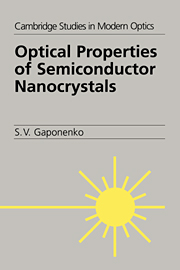Book contents
- Frontmatter
- Contents
- Preface
- 1 Electron states in crystal
- 2 Electron states in an ideal nanocrystal
- 3 Growth of nanocrystals
- 4 General properties of spectrally inhomogeneous media
- 5 Absorption and emission of light by semiconductor nanocrystals
- 6 Resonant optical nonlinearities and related many-body effects
- 7 Interface effects
- 8 Spatially organized ensembles of nanocrystals
- References
- Index
Preface
Published online by Cambridge University Press: 09 October 2009
- Frontmatter
- Contents
- Preface
- 1 Electron states in crystal
- 2 Electron states in an ideal nanocrystal
- 3 Growth of nanocrystals
- 4 General properties of spectrally inhomogeneous media
- 5 Absorption and emission of light by semiconductor nanocrystals
- 6 Resonant optical nonlinearities and related many-body effects
- 7 Interface effects
- 8 Spatially organized ensembles of nanocrystals
- References
- Index
Summary
Electronic states and probabilities of optical transitions in molecules and crystals are determined by the properties of atoms and their spatial arrangement. An electron in an atom possesses a discrete set of states, resulting in a corresponding set of narrow absorption and emission lines. Elementary excitations in an electron subsystem of a crystal, that is, electrons and holes, possess many properties of a gas of free particles. In semiconductors, broad bands of the allowed electron and hole states separated by a forbidden gap give rise to characteristic absorption and emission features completely dissimilar to atomic spectra. It is therefore reasonable to pose a question: What happens on the way from atom to crystal? The answer to this question can be found in the studies of small particles with the number of atoms ranging from a few atoms to several hundreds of thousands atoms. The evolution of the properties of matter from atom to crystal can be described in terms of the two steps: from atom to cluster and from cluster to crystal.
The main distinctive feature of clusters is the discrete set of the number of atoms organized in a cluster. These so-called magic numbers determine unambiguously the spatial configuration, electronic spectra, and optical properties of clusters. Sometimes a transition from a given magic number to the neighboring one results in a drastic change in energy levels and optical transition probabilities.
- Type
- Chapter
- Information
- Optical Properties of Semiconductor Nanocrystals , pp. xi - xivPublisher: Cambridge University PressPrint publication year: 1998



